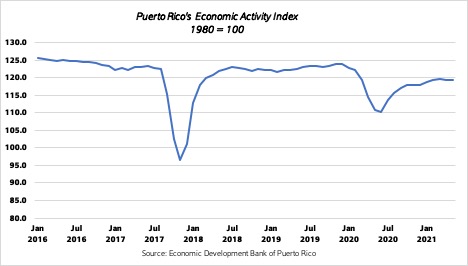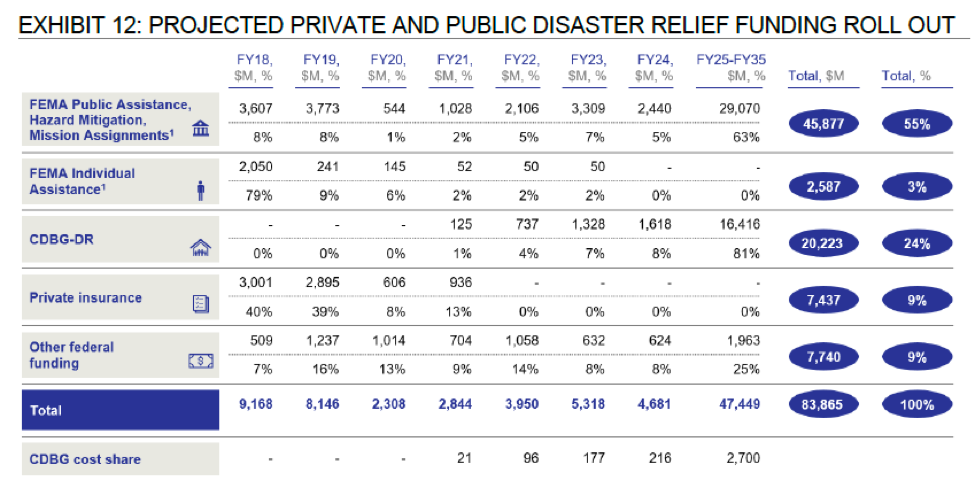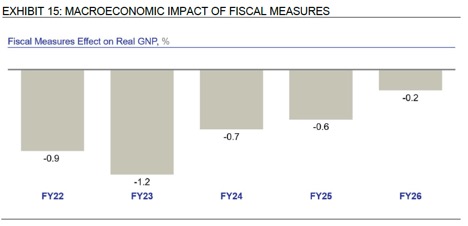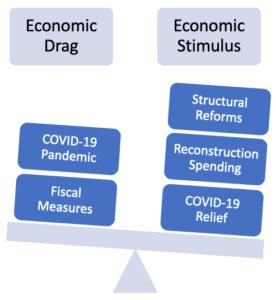The Threefold Challenge to the Puerto Rican Economy
Published on September 15, 2021 / Leer en español
Introduction
The Puerto Rican economy is simultaneously recovering from three systemic shocks:
- The COVID-19 pandemic, which has adversely affected economic activity since the spring of 2020, is still an ongoing, developing event. We really don’t know what the recovery from a global pandemic looks like, how long it will take, or which long-term structural shifts will flow from it.
- Four years after Hurricanes Irma and Maria, Puerto Rico is still recovering from the considerable damage inflicted by these storms. While a lot of work has been done over the last four years, the remaining agenda of rebuilding schools, roads, and public health facilities and of mitigating existing risks to life and limb, is quite challenging.
- Finally, the government of Puerto Rico is entering a critical phase of its debt restructuring process as ballots will be sent soon to creditors so they can vote on the Plan of Adjustment (“POA”) negotiated by the Fiscal Oversight and Management Board (“FOMB”). The POA has to be, among other things, in compliance with the Fiscal Plan for the central government and found by the court to be viable and in the best interests of the creditors. If certified by the court, Puerto Rico’s bankruptcy will be officially over and the POA will govern Puerto Rico’s fiscal policy for the next 25 years.
So, the agenda for Puerto Rico is full, to say the least. We hope the breakdown and brief analysis of these threefold challenges we provide in this brief will be helpful to you in making sense of a complicated situation.
The COVID-19 Pandemic 
In June 2020, the International Monetary Fund (“IMF”) described the COVID-19 pandemic as a “crisis like no other”. At that time approximately 90% of the world economies went into recession simultaneously, the highest share since 1871; global GDP was expected to decline by 4.9%, and the expectations were for forgone production to add up to trillions of losses and millions of jobs destroyed.
A year later, the direst predictions have not been realized, thanks in large part to unprecedented policy support from the public sector. In the United States alone, Congress has authorized approximately $5 trillion in new pandemic-related spending, while the Federal Reserve has provided the financial system with an additional $4 trillion in liquidity. As a result, economic activity, income, and savings in the U.S. are already at or above pre-pandemic levels.
It would be a mistake, though, to assume the crisis is over. Total employment in the U.S. is currently some six million jobs below its February 2020 level; millions of renters risk losing their homes as moratoria on evictions end (or are found to be otherwise illegal); and the inflation rate is at levels unseen in a generation.
In Puerto Rico, just like in the rest of the world, the impact of the COVID-19 pandemic was swift and severe. As shown in the chart below, total non-farm employment decreased from 887,300 in March 2020 to 766,800 in April 2020, a loss of 120,500 jobs, or approximately 13.5% of the total. By June 2021, total employment had recuperated to about 853,800, which means we have made up for about two-thirds of the loss in employment.

Source: U.S. Bureau of Labor Statistics
In terms of economic activity, the story is quite similar. According to data from the Puerto Rico Economic Development Bank, the Puerto Rico Economic Activity Index decreased from 122.1 in February of 2020 to 110.1 in June 2020, a decrease of 12 points or approximately 9.8%. As of June 2021, the index had a value of 118.9 points, which, again, means we have made up for about two-thirds of the loss in economic activity.

Keep in mind that this relatively rapid recovery is due largely to the positive effect of federal spending related to the COVID-19 pandemic. According to the FOMB, Puerto Rico is expected to receive $43.5 billion in federal assistance related to COVID-19 over the FY2020—FY2023 period. The most recent Fiscal Plan for the Commonwealth estimates that “around 60% of this income support funding will be spent”, while the “remaining 40% of funds is projected to be saved and/or used to pay down debt, and then is spent over a 30 -year period according to the long -term consumption smoothing concept”. Thus, most of the economic support provided by this spending is already “baked-in” into current economic indicators.
In the short term, however, the COVID-19 pandemic is the most significant source of economic risk and uncertainty. While we have learned a substantial amount about the SARS-CoV-2 virus over the last eighteen months, the virus has also consistently confounded the best scientific minds on the planet. We are now in a race against the virus, trying to vaccinate the largest amount of people around the world before the virus evolves a vaccine-resistant variant. To the extent significant pockets of unvaccinated populations remain in the U.S. and around the world this risk will increase.
Eventually, though, we can expect the COVID-19 virus to reach a sort of equilibrium with its human hosts. For many experts, that will occur when the amount of people who have acquired immunity to the virus, either through vaccination or prior infection, is high enough to make this virus look more like the seasonal flu. It is unknown exactly when that will happen, but recent events in Florida, Mississippi, and Texas show we are still far from reaching that point. Until then, we will continue to see significant economic disruptions, recurring demand-supply imbalances, and periodic shipping logjams, with many governments continuously tightening and loosening restrictions on business and economic activity as the virus continues to wax and wane in accordance with its own evolutionary logic.
Hurricane Maria Reconstruction 
Four years after Hurricane Maria wreaked havoc on the island and generated some $90 billion in damages, the pace of reconstruction remains slow — while Congress has allocated $64 billion for disaster relief and recovery operations in the island, as of June 30, 2021, only $18.6 billion, or approximately 29%, has been spent. Furthermore, some of the most important work — refurbishing and modernizing the electric grid; rebuilding schools, housing, roads, bridges, and healthcare facilities; and undertaking mitigation activities to increase resiliency and reduce the risk exposure of vulnerable populations — has not yet begun.
According to the FOMB, the pace of federal disbursements, and hopefully the reconstruction work, should pick up during the next couple of years. As shown in the table below, the Board expects disaster recovery expenditures to amount to $3.95 billion, $5.31 billion, and $4.68 billion for each of fiscal years 2022, 2023, and 2024, respectively. That would be equivalent to 5.6%, 7.5%, and 6.6% of nominal GNP in 2020. We note, though, that the bulk of recovery funding, some $47.44 billion, is scheduled to be disbursed during the ten-year period between 2025 and 2035.

Source: FOMB Certified Fiscal Plan for Puerto Rico – April 23, 2021
This delayed disbursement schedule presents several risks for Puerto Rico. For example, Congress may reprogram funding allocated for disaster recovery in the island, while the economic impact during any given year is diluted as funds are spent over 15 years. Conversely, the extended timeline may allow Puerto Rico to properly implement procurement regulations, auditing controls, and other compliance mechanisms required by the federal government and to avoid a foreseeable shortage of the skilled labor required for some of these large infrastructure projects.
In the end, however, the main risk regarding the Hurricane Maria reconstruction could be the creation of a false sense of complacency as the economy begins to grow when the federal money starts to flow. It would be a mistake to believe that our economic problems will be over once the disbursement of federal reconstruction funding begins in earnest for at least two reasons.
First, all that economic activity will be financed with federal funds transferred to Puerto Rico’s government instead of locally generated resources. It may be easy to forget that once the good times are rolling and erroneously believe the reconstruction is driven by the strengthening of the Puerto Rican economy, when in fact it is powered by Congressional largesse.
Second, the reconstruction process, by its nature, is designed to rebuild and repair what was damaged or destroyed by Hurricane Maria. In that sense, its main objective is to restore Puerto Rico’s capital endowment to its pre-hurricane state. The reconstruction of damaged or lost assets does not constitute a net addition to the island’s long-term productive capacity.
The Fiscal Plan and the POA 
The Fiscal Plan certified by the FOMB for the central government sets in motion policies that have inconsistent effects on the real economy. First, the FOMB continues with the implementation of fiscal austerity measures, which it estimates will reduce GNP by 0.9%, 1.2%, and 0.7% during fiscal years 2022 (ongoing), 2023, and 2024, respectively. In their view, this fiscal consolidation is necessary to balance the budget in the short term. Note that the fiscal consolidation scheduled for FY2023 is particularly deep.

Source: FOMB Certified Fiscal Plan for Puerto Rico – April 23, 2021
On the other side of the equation, the FOMB is promoting the implementation of “structural reforms” in the areas of social welfare, energy, and ease of doing business, which it estimates will have a cumulative positive impact equal to 0.75% of GNP by fiscal year 2026. It is unclear, though, whether the government of Puerto Rico has the capability to implement these policies and, if implemented, whether they will have the economic impact forecasted by the FOMB.
In general, then, the certified fiscal plan would be a net drag on economic activity in the absence of other expansionary policy measures. The FOMB, however, believes that fiscal drag is reduced or eliminated completely when it factors in federal spending related to (1) the COVID-19 pandemic and (2) the reconstruction of the damage caused by Hurricane Maria.

Source: FOMB Certified Fiscal Plan for Puerto Rico – April 23, 2021
That bet, though, is not a sure thing. As we stated above, most of the COVID-19 funds have been spent already and the bulk of the reconstruction money is scheduled to be disbursed after FY 2025. Other risks to the Fiscal Plan include the potential loss of excise tax revenues from Act 154 and the loss or reduction of federal Medicaid funds. How this game of fiscal weights and counterweights plays out is important because the Fiscal Plan is the master document upon which the long-term Plan of Adjustment is based.

The POA will govern the restructuring of the central government obligations with 69 different classes of creditors and will determine Puerto Rico’s fiscal policy for the next 25 years. At the time of this writing, we don’t have all the information necessary to calculate a weighted average recovery, but creditor recovery rates range from 10% for certain unsecured creditors to 91.5% for government retirees. Some creditors will receive cash, others a combination of cash and new bonds, and still others will receive contingent value instruments, whose repayment depends on achieving certain revenue targets.
The POA will also require the government of Puerto Rico to pay annual debt service on the new bonds of approximately $1 billion and make yearly pension payments of about $2 billion, relative to a FY2022 general fund budget of approximately $10 billion. A full analysis of the POA is beyond the scope of this CNE Review but we should note that everything depends upon jumpstarting economic growth in Puerto Rico, which is necessary to generate the required government revenues to comply with the POA. And economic growth in the short term depends on the disbursement and successful management of federal funds and, to a lesser extent, the implementation of the “structural reforms” favored by the FOMB.
Conclusion 
Puerto Rico’s short-term economic performance is overshadowed by a large cloud of uncertainty, as the island’s government concurrently addresses the impacts of three systemic shocks: the COVID-19 pandemic, Hurricane Maria, and the bankruptcy of the central government. Each of these processes generates its own set of risks, which oftentimes could interact among and between them in complex ways. For example, the implementation of fiscal measures to balance the budget could affect the capacity of the state to manage complex projects, while supply chain bottlenecks and inflation due to the COVID-19 pandemic may delay Hurricane Maria’s reconstruction efforts.
At a deeper level, however, it is worrisome that economic growth in the short term depends mostly on the receipt of federal transfers that we do not control. We worry that these expenditures will have a temporary positive impact on the economy that may set back efforts to develop a medium/long-term economic strategy or plan for Puerto Rico. Let’s avoid that trap and keep focused on addressing the structural factors that are the root cause of Puerto Rico’s long-term economic stagnation.

